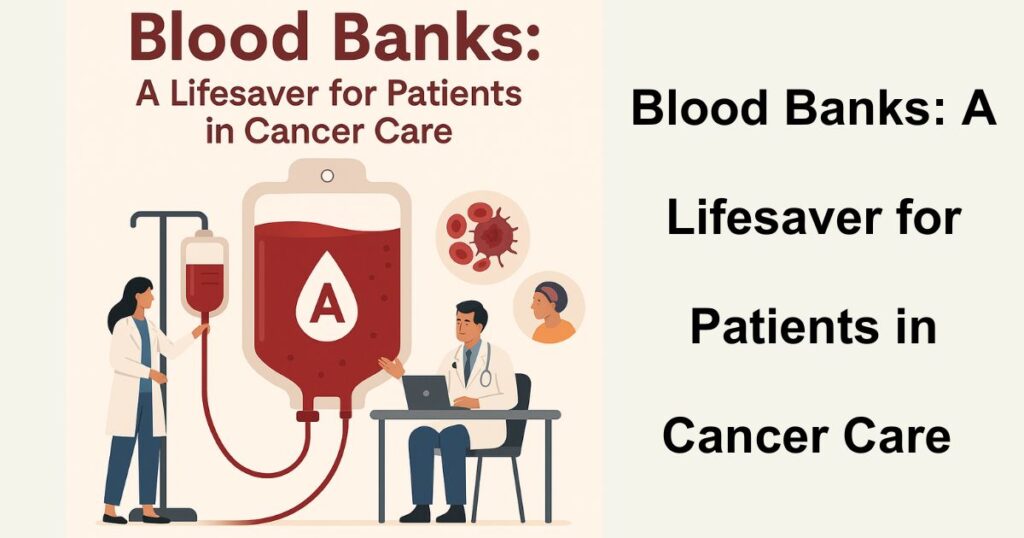For individuals undergoing cancer treatment, access to timely and safe blood transfusions is often just as critical as chemotherapy or radiation. Blood banks play a vital role in supporting cancer care, particularly in advanced medical centers like a leading Cancer Hospital In Chennai, where modern therapies often depend on blood components for patient survival. These facilities, in collaboration with oncologists and hematologists, ensure the continuous supply of blood products, which are essential for managing complications related to cancer and its treatment.
The Critical Need for Blood in Cancer Treatment
Cancer can affect the body’s ability to produce healthy blood cells. This is especially true for cancers that originate in or affect the bone marrow, such as leukemia, lymphoma, or multiple myeloma. Additionally, treatments like chemotherapy and radiation therapy can damage bone marrow, resulting in anemia, low platelet counts, or other blood disorders.
In such cases, patients may require transfusions of red blood cells to combat anemia, platelets to prevent bleeding, or plasma to help with clotting. Without these life-saving transfusions, the body’s ability to recover and continue treatment would be severely compromised. Blood banks ensure that these products are available, properly screened, and matched for each patient’s safety.
Types of Blood Products Used in Cancer Care
Cancer patients often require different components of blood depending on their condition and treatment. The primary blood products used include:
- Red Blood Cells (RBCs):These are commonly given to patients experiencing anemia, a condition marked by low hemoglobin levels. Anemia in cancer patients is usually due to the cancer itself or as a side effect of treatment. RBC transfusions help improve oxygen transport throughout the body, reducing fatigue and improving quality of life.
- Platelets:Platelets help the blood to clot. Many chemotherapy drugs reduce platelet production, putting patients at risk of spontaneous bleeding. Platelet transfusions can help mitigate this risk and are often given before or after intensive treatments.
- Plasma:Plasma contains clotting factors and proteins needed to control bleeding. Patients with liver cancer or those who develop clotting disorders may need plasma transfusions.
Each of these components is collected, processed, and stored by blood banks under stringent safety standards to meet the individualized needs of cancer patients.
How Blood Banks Operate in Cancer Care
A modern Blood Bank In Chennai typically functions as a highly coordinated system. It includes donor recruitment, blood collection, processing, testing, storage, and distribution. Here’s a closer look at each stage:
- Donor Recruitment and Collection:Healthy volunteers donate blood either as whole blood or through apheresis, a process that separates blood components during donation.
- Testing and Processing:After collection, the blood is rigorously tested for infections such as HIV, hepatitis B and C, and other transfusion-transmissible diseases. The blood is then separated into components (RBCs, platelets, plasma) and stored at appropriate temperatures.
- Inventory Management:Blood banks maintain a carefully monitored inventory to ensure the right blood type and components are available when needed. Specialized software systems help track donation expiry, usage rates, and stock levels.
- Compatibility and Safety Checks:Before transfusion, blood types are matched to ensure compatibility. In cancer patients, this is particularly important as their immune systems may be compromised.
Blood banks are often integrated with cancer hospitals and diagnostic centers to ensure rapid response in emergencies and during treatment procedures that require transfusion support.
Blood Donations: A Community’s Contribution to Cancer Recovery
Blood banks heavily depend on regular voluntary donations. Cancer care centers frequently run awareness campaigns and organize blood donation drives, emphasizing the importance of community involvement. Since cancer patients may require multiple transfusions over their treatment span, a single patient may benefit from numerous donors.
Additionally, the need for specific blood types, such as rare or Rh-negative groups, makes it important for diverse donor pools to participate. Donors are encouraged to give not just whole blood but also specific components like platelets or plasma through apheresis.
By donating blood, individuals are directly contributing to the survival and recovery of cancer patients in their own communities.
Challenges Faced by Blood Banks in Cancer Care
Despite the indispensable role they play, blood banks face numerous challenges:
- Shortage of Donors:There is often a gap between demand and supply, especially during public holidays or health crises like pandemics.
- Blood Wastage:Improper storage or lack of demand for specific components can lead to expiration and wastage.
- Logistics and Infrastructure:Maintaining the cold chain, ensuring safe transport, and updating inventory systems are essential but resource-intensive tasks.
- Awareness and Misconceptions:Many people are hesitant to donate blood due to fears or lack of information. Increasing awareness about the safety and necessity of blood donation is crucial.
The Way Forward: Enhancing Blood Support in Cancer Care
To better support cancer patients, blood banks and healthcare providers can implement several measures:
- Encourage Repeat Donors:Creating a database of regular donors and encouraging scheduled donations can ensure a steady supply.
- Technology Integration:Using AI and data analytics to forecast demand and manage inventory helps reduce wastage and shortages.
- Public Education Campaigns:Educating the public about the benefits of blood donation and its impact on cancer care can boost donor participation.
- Partnerships with Cancer Hospitals:Closer collaboration between blood banks and oncology departments can streamline transfusion planning and improve patient outcomes.
Conclusion
In the complex world of cancer care, blood banks are silent yet powerful allies. From replenishing blood cells damaged by chemotherapy to preventing life-threatening bleeding, their role is multifaceted and essential. Every unit of blood donated has the potential to extend or even save a life. Whether you are a medical professional, a patient, or a member of the public, understanding the critical link between blood donation and cancer treatment empowers you to make a difference.

